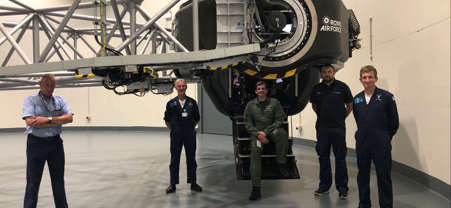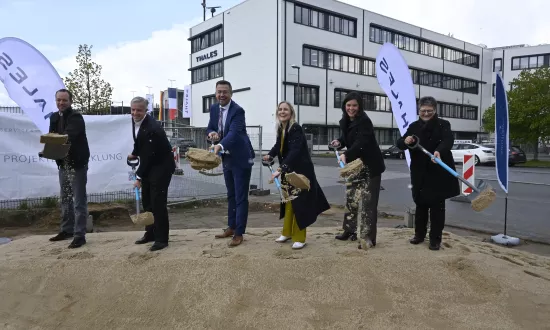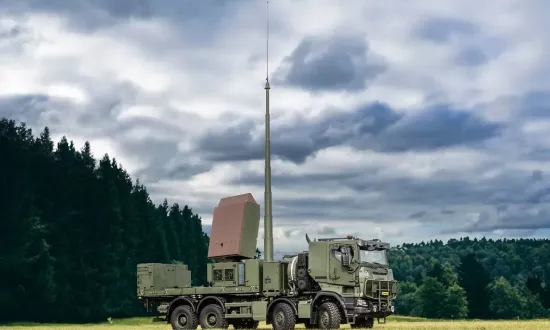1000 High-G spins marks a significant milestone for our partnership with the RAF
Since starting training in October 2018, training for RAF pilots has been delivered through a Thales and RAFCAM partnership, with a team of 10 Thales employees based at the HGTTF, RAF Cranwell.
In service, HGTTF has exceeded training targets and proved itself to be safe and very reliable, with overwhelmingly positive feedback from aircrew undergoing training.
The Thales team has received the personal thanks of some of the highest-ranking officers in the RAF for their hard work and dedication for continuing to deliver an excellent service, even during lockdown.
David Bolsover, Training Service Manager at HGTTF, said:
“We have opened a world leading facility that is making a significant impact to flight safety for our frontline personnel in the MoD. I am incredibly proud and grateful to our Thales team who have also been recognised by the RAF for going above and beyond to continue operations at HGTTF, during what has been a very challenging time with COVID19."

|
The HGTTF officially opened on 4 Feb 2019, at RAF Cranwell in Sleaford, Lincolnshire. Thales along with AMST (Original Engineering Manufacturers) delivered the training facility on time and to cost. |
Training pilots on G-force
For their safety, all aircrew must have a medical examination each year to check that they remain fit to fly. Part of the examination includes G-force training at HGTTF. Each person responds differently to the effects of G-force, such as the heart rate increasing in order to supply sufficient blood flow to the brain. Not enough blood flowing to the brain can cause a ‘grey-out’.
‘Grey-out’ affects people in different ways; for some, the effects can be ‘grey curtains’ closing in from the periphery of your vision; for others it may be ‘sparkles’, small stars that appear in your field of vision; or you can lose your colour vision.
Some people can withstand up to 5G, or five times the level of gravity we experience on the Earth’s surface, without any effect at all. However, others can start to feel effects as low as 3G. So, as part of their flying training, they are trained to experience ‘grey-out’, to find out what their ‘G’ level is, and how to recognise it in themselves.
The basic High-G training we deliver is for RAF officer graduates who join the Elementary Flying Training (EFT) School at RAF Cranwell – this represents 175 of the 1000 spins so far. Following streaming as Fast Jet, Multi-engine or Rotary pilots, Fast Jet stream students undergo courses to prepare them for Texan and Hawk basic and advanced trainers before further selection for either Lightning or Typhoon. They then undertake more High-G training up to 9G during pre-conversion training.
Since opening, we’ve also delivered several courses for aviation doctors which forms part of their Aviation Medical Diploma. They are required to undergo High-G training so that they can teach aircrew how to resist G-Force.
Whole Force teamwork with RAFCAM
During the procurement and definition phase of the programme, Thales worked closely with RAFCAM to ensure that the facility and the training it would provide would meet their exacting requirements.
Since the facility’s opening, its Thales instructors, working alongside colleagues in the Aviation Medicine Training Wing of RAFCAM, have developed training syllabi to cover all High-G aspects of RAF, Navy and Army pilot and aircrew training. In addition, they have jointly developed training for Military Aviation Medical Examiners, students on the Diploma in Aviation Medicine and Operational Aviation Medicine courses.
As a result of our seamless collaboration, RAFCAM classes the facility as ‘World leading in High-G training’ and view it as an integral part of their Aviation Medicine training facilities.

Testing equipment and physiological trials
The 1000 spins are only half of what we deliver at HGTTF; the other half consists of trials of equipment and physiological trials. Testing is done on new equipment to go into aircraft and on new helmets and G-suits. Medical trials are also carried out on human physiology, such as research into the effects of G-force on brainwaves.
You can find out more on the High G Training and Test Facility on our website by clicking here.


